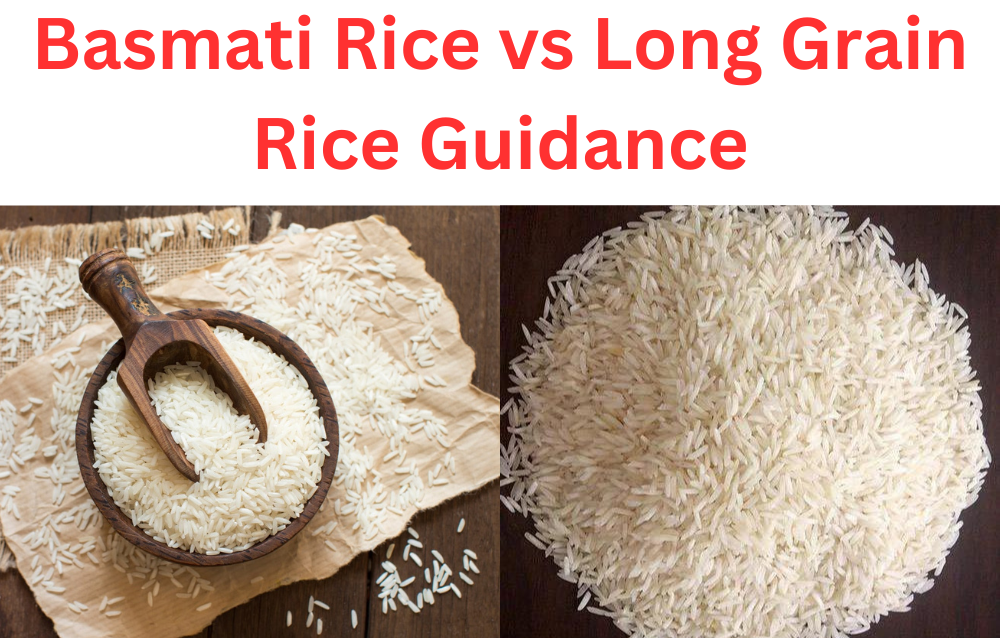“Select between long-grain rice Vs basmati rice. Your dish, your peace of mind, with flavorful bless or flexible comfort. One choice, two grains, and a stronger taste.”
Basmati Rice And Long Grain Rice Comparison!
When it comes to food choices, choosing rice is more than simply a matter of need. It’s an identity that is a work in progress that can be customized with one’s creative ideas. With numerous different types of rice available. The choice between long-grain rice vs basmati rice becomes a pickle because each grain has a distinct taste.
The importance of finding happiness in oneself and eating healthy food. Captures the idea that choosing between basmati vs long-grain rice nutrition has more to do with satisfying experiences than just meeting the needs of the body. It speaks to the idea that eating includes more than just consuming food. Another factor is how the flavors and materials combine to create a wonderful and fulfilling meal.
Therefore, if you find yourself to choose between long-grain rice and basmati rice. Keep in mind that the choice goes beyond grain-based foods. It’s an opportunity to tailor your dining experience, a journey where your plate becomes a piece of art. It is the combination of flavorful improvement and flexible relief that brings you peace.
Long-Grain and Basmati Rice Found in the USA
Let’s explore long-grain and Basmati rice varieties that are generally found in the United States of America.
1) Source and Types Of Rice
Basmati Rice: Produced in particular areas of India and Pakistan, basmati rice is formerly from the Indian subcontinent. Multiple brands of basmati rice can be found in the USA, and it tends to be imported.
Long-grain Rice: The United States of America is a producer of several long-grain varieties of rice. Such as Caroline long-grain rice, Southern long-grain rice, and other regionally produced varieties. There could be shifts in the flavor, consistency, and looks of these types.
2) Taste and smell of Fragrance of Rice
Basmati Rice: Considered for its unique smell, cooked basmati rice produces a rich smell.
Further research reveals that its unique flavor offers meals of a higher quality.
Long-Grain Rice: Although long-grain rice in the USA might smell a bit, it usually doesn’t have the powerful smell of Basmati rice. Because of its more impartial flavor, it can be used in a wide range of food circumstances.
3) Length and Visual Appearance of Rice
Basmati Rice: The long, thin grains of basmati rice look like threads. They expand and separate themselves from one another when they cook.
Long-Grain Rice: American long-grain rice varieties are distinguished by expanded grains, though their exact form varies based on the selection. The grains could not be as thin as those of Basmati.
4) Flavor and Use of Rice in Cooking
Basmati Rice: When cooked, basmati rice keeps its fluffy, unique texture and rigid texture. It is frequently used in Indian and South Asian dishes, such as pilafs and biryanis.
Long-Grain Rice: American long-grain rice is responsive and works well in many different recipes. It works well in recipes that require a less fluid form, such as stir-frying, dishes like casseroles, and snacks.
5) Products and Brands of Rice
Basmati Rice: Various brands of basmati rice are sold in the United States in both regular supermarkets and specialty markets. Brands of Basmati rice that are famous include Daawat, Royal, and Tilda.
Long-Grain Rice: Grocery stores usually carry long-grain rice varieties that are produced in the USA. The Brands are represented by Carolina Rice and Mahatma.
6) Historical Impacts of Rice
Basmati Rice: South Asian food customs have deep roots in the use of basmati rice. It is an integral component in meals like pilafs, biryanis, and other uplifting parties.
Long-Grain Rice: long-grain rice is the foundation of cooking, appearing in dishes, rice plates, and as a side dish to a variety of primary meals.
7) Food Composition of Rice
Basmati Rice: Rich in vital nutrients such as B vitamins. Carbohydrates can be properly obtained from basmati rice. Compared to certain other rice varieties. It has an inferior glycemic index or blood sugar level.
Long-Grain Rice: Long-grain rice varieties provide carbohydrates and likely vital nutrients. Particularly brown long-grain rice keeps greater of its organic grain layer. Which adds additional dietary fiber, vitamins and minerals.
8) Supply and Availability of Rice
Basmati Rice: Commonly wrapped in feature, long bags or containers, basmati rice can be purchased in both white and brown types.
Long-Grain: Long-grain rice comes in a variety of options for packaging, such as boxes, bags, and bulk. The USA’s supermarkets generally carry the white and brown varieties.
9) Trade in Business of Rice
Basmati Rice: Exports of basmati rice from Pakistan and India have been sold in several countries, including the United States.
if you want to know more about the Basmati Rice you can go through this link: Types of Basmati Rice
Long-grain: The United States of America is an important buyer of long-grain rice and the nation’s rice business. It provides significant demand on the domestic as well as global frontal systems.
Long Grain or Basmati Rice?
In the end, choosing between long-grain rice vs basmati rice is based on the specific demands of the meal. Specific tastes and a long history of food knowledge. Long-grain and basmati rice are now standards in kitchens all over the world due to their unique smells and strong qualities. Adding to the variety of flavors that make up dishes across the globe. Both long-grain and basmati rice help to create numerous and lasting food memories that make the world of food more prosperous.
FAQs
Where does Basmati rice originate from, and what about long grain rice?
Basmati rice is primarily grown in the Indian subcontinent, particularly in India and Pakistan. Long grain rice is a broader category that includes rice varieties from various regions, including the United States, Thailand, and China.
what is the difference between basmati brown rice vs long grain brown rice?
Basmati: Origin: Indian subcontinent (India, Pakistan)
Grain: Longer, slimmer
Aroma: Nutty, floral
Texture: Separate, fluffy
Ideal for: Aromatic dishes (curries, biryanis)
Long Grain: Origin: Various regions (U.S., Thailand, China)
Grain: Long, slender (not as elongated as Basmati)
Aroma: Milder, neutral flavor
Texture: Can maintain separate texture
Versatile for: Various cuisines and recipes
Are there nutritional differences between Basmati and long grain rice?
Nutritionally, both types are similar and provide a good source of carbohydrates. However, specific nutrient content may vary depending on the variety and processing methods.














